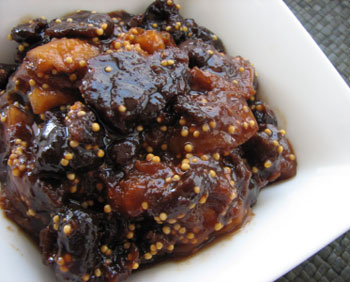 I spent a year living in Europe, and six months of that was in Italy. Having eaten a lot of Italian food, I like to think I understand it, perhaps just a little. In fact, whenever I try to recreate an Italian dish I think back to earlier versions that I've eaten. What was it that I liked about it? What was the essence of the dish?
I spent a year living in Europe, and six months of that was in Italy. Having eaten a lot of Italian food, I like to think I understand it, perhaps just a little. In fact, whenever I try to recreate an Italian dish I think back to earlier versions that I've eaten. What was it that I liked about it? What was the essence of the dish?
In all my time in Italy, I don't remember trying mostarda. It's not surprising really because the most well-known versions come from Veneto, Lombardia and Piemonte. Most of my time was spent in Tuscany. But I still think I understand mostarda, just a bit. It's like an Italian chutney I suppose. Don't make the mistake of translating it as "mustard". Mostarda does have a little bit of mustard in it, but it's really a combination of preserved fruit in syrup with a bit of a kick. The kick comes from mustard oil, mustard essence, dry mustard, mustard seeds or some combination thereof. Other ingredients include sugar or honey, wine, vinegar and sometimes citrus juice.
When I am developing a recipe, I often look for several variations then strike off on my own. The recipes I found for mostarda varied greatly--some used dry fruit, others fresh fruit. Some cooked slowly others cooked quickly. Some had lots of mustard, others barely a pinch. My own experiment lead me to this conclusion: Mostarda is very forgiving and can easily be made to your own taste. You can taste as you go and make changes.
Here's how I made my first version. Please note all amounts are approximations. I'm including the links to the recipes that influenced my own recipe. Mario Batali's version at the Food Network, one from About.com's Italian Food section, Food and Wine's recipe and a particularly tedious thread on eGullet on the subject.
My Mostarda
makes about 3 cups
Ingredients:
1 cup dried cherries
1/2 cup dried figs, chopped
6 small apricots cut into quarters
1 apple, peeled and chopped
1 cup sugar
1 cup white wine
2 Tablespoons white wine vinegar
2 Tablespoons light mustard seeds
1 Tablespoons dry mustard powder
Instructions:
Place the dried fruit in a non-reactive saucepan and barely cover with water. Add the sugar, wine and vinegar. Simmer very gently for 10 minutes. Add the fresh fruit, mustard seeds and mustard powder and continue just barely simmering for another 10 minutes. The fruit should hold it's shape but be supple and moist. Taste for seasonings. Add more water or wine or mustard as you wish. The finished product should be somewhat thick and syrupy. Serve with pate, charcuterie, cheese, or a boiled dinner like bollito misto. Store in the refrigerator.
Enjoy!
Amy Sherman is a San Francisco–based writer, recipe developer, restaurant reviewer and all around culinary enthusiast. She blogs for Epicurious , Bay Area Bites and Cooking with Amy .

